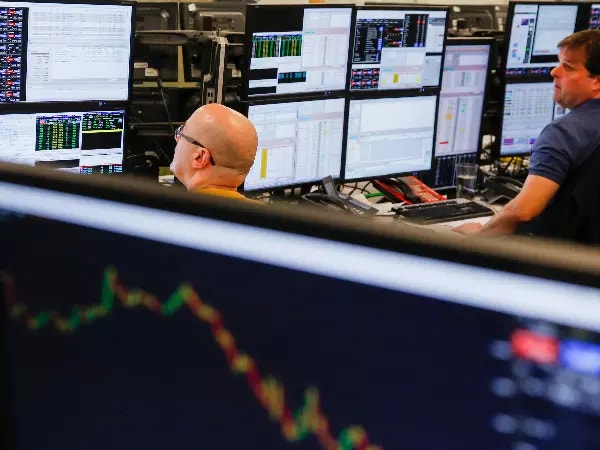Bull flag and bear flag chart patterns explained
Bull and bear flags are popular price patterns recognized in technical analysis, which traders often use to identify trend continuations. In this article we look at how to trade these opportunities.

What are bull and bear flag patterns?
Bull and bear flag formations are price patterns which occur frequently across varying time frames in financial markets. These patterns are considered continuation patterns in technical analysis terms, as they have a habit of occurring before the trend which preceded their formation is continued.
In this article, we look at how to identify and trade these patterns by looking for entries and exits through breakouts, proportionate targets, failure levels and volume confirmations.
The strong directional move up is known as the ‘flagpole’, while the slow counter trend move lower is what is referred to as the ‘flag’.
In an uptrend a bull flag will highlight a slow consolidation lower after an aggressive move higher. This suggests more buying enthusiasm on the move up than on the move down and alludes to the momentum as remaining positive for the security in question.
Traders of a bull flag might wait for the price to break above the resistance of the consolidation to find long entry into the market. The breakout suggests the trend which preceded its formation is now being continued.
A trading target from the breakout is often derived by measuring the height of the preceding trend (flagpole) and projecting a proportionate distance from the breakout level.
In terms of managing risk, a price move below the support of the flag formation may be used as the stop-loss or failure level.
In a downtrend a bear flag will highlight a slow consolidation higher after an aggressive move lower. This suggests more selling enthusiasm on the move down than on the move up and alludes to the momentum as remaining negative for the security in question.
Traders of a bear flag might wait for the price to break below the support of the consolidation to find short entry into the market. The breakout suggests the trend which preceded its formation is now being continued.
A trading target from the breakout is often derived by measuring the height of the preceding trend (flagpole) and projecting a proportionate distance from the breakout level.
In terms of managing risk, a price move above the resistance of the flag formation may be used as the stop-loss or failure level.
Trading bull and bear flags with volume patterns
Volume patterns may often be used in conjunction with flag patterns, with the aim of further validating these formations and their assumed outcomes.
Trading bear flags with volume confirmations
In a bear flag formation, traders will hope to see high or increasing volume into the flagpole (trend which precedes the flag). The increasing or higher than usual volume accompanying the downtrend (flagpole), suggests an increased sell side enthusiasm for the security in question.
The flag, which represents a consolidation and slow pullback from the downtrend, should ideally have low or declining volume into its formation. This shows less buying enthusiasm into the counter trend move.
The high volume into the move lower (flagpole) and low volume into the move higher, are suggestions that the overall momentum for the market being traded is negative. This furthers the assumption that the preceding downtrend is likely to continue.
The above chart highlights high and increasing volume levels into a downtrend, suggesting a strong sell side momentum, while the chart below highlights low and declining volume levels into the flag consolidation, showing diminished interest into the gradual move higher.
Together these charts illustrate the favorable volume patterns traders will be looking to identify into a bear flag, which assumes continued price weakness to follow.
Trading bull flags with volume confirmations
In a bull flag formation, traders will hope to see high or increasing volume into the flagpole (trend which precedes the flag). The increasing or higher than usual volume accompanying the uptrend (flagpole), suggests an increased buy side enthusiasm for the security in question.
The flag, which represents a consolidation and slow pullback from the uptrend, should ideally have low or declining volume into its formation. This shows less buying enthusiasm into the counter trend move.
The high volume into the move higher (flagpole) and low volume into the move lower, are suggestions that the overall momentum for the market being traded is positive, furthering the assumption that the uptrend is likely to continue.
The above chart highlights high and increasing volume levels into an uptrend, suggesting a strong buy side momentum, while the chart below highlights low and declining volume levels into the flag consolidation, showing diminished interest into the gradual move lower.
Together these charts illustrate the favorable volume patterns traders will be looking to identify into a bull flag, which assumes continued price gains to follow.
High volume breakout
Traders of bull and bear flag patterns might hope to see the breakout accompanied by a high-volume bar. A high-volume bar to accompany the breakout, suggests a strong force in the move which shifts the price out of consolidation and into a renewed trend. A high-volume breakout is a suggestion that the direction in which the breakout occurred, is more likely to be sustained.
The below chart highlights an upside breakout from a bull flag pattern, which is accompanied by a high-volume bar. The high volume confirms the breakout and suggests a greater validity and sustainability to the move higher. In a downtrend the same principle or suggestions would apply, ie a high-volume downside breakout from a bearish flag consolidation, would allude to a greater validity and sustainability to the move lower.
Bull flag and bear flag patterns summed up
- A flag is considered a continuation pattern in technical analysis
- The ‘flagpole’ represents the trend which precedes the ’flag’
- The ‘flag’ highlights a consolidation after a trend
- A bull flag suggests that the preceding uptrend will be continued
- A bear flag suggests that the preceding downtrend will be continued
- The height of the flagpole projected from the breakout level will arrive at a proportionate target
- When trading a bull flag, traders might use a move below the lower level of support as a stop-loss or failure level
- When trading a bear flag, traders might use a move above the upper level of resistance as a stop-loss or failure level
- Volume patterns are often used to confirm bull and bear flag price patterns
- In a bull flag, rising volume into the flagpole and declining volume into the flag validates the pattern and assumptions that the preceding uptrend will be continued
- In a bear flag, rising volume into the flagpole and declining volume into the flag validates the pattern and assumptions that the preceding downtrend will be continued
- A high-volume bar on a flag breakout, suggests a higher probability of the patterns success
This information has been prepared by tastyfx, a trading name of tastyfx LLC. This material does not contain a record of our trading prices, or an offer of, or solicitation for, a transaction in any financial instrument. You should not treat any opinion expressed in this material as a specific inducement to make any investment or follow any strategy, but only as an expression of opinion. This material does not consider your investment objectives, financial situation or needs and is not intended as recommendations appropriate for you. No representation or warranty is given as to the accuracy or completeness of the above information. tastyfx accepts no responsibility for any use that may be made of these comments and for any consequences that result. See our Summary Conflicts Policy, available on our website.
